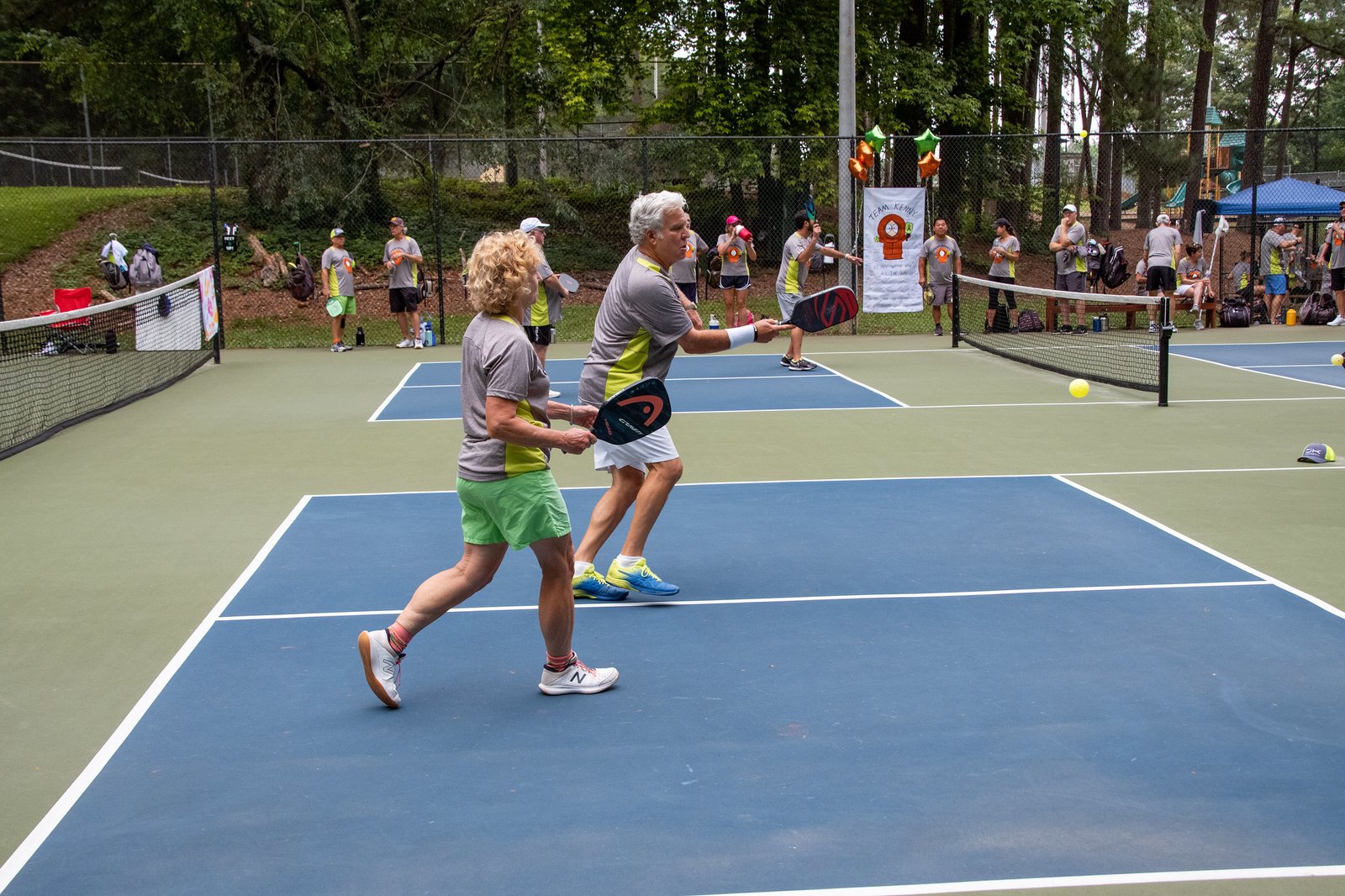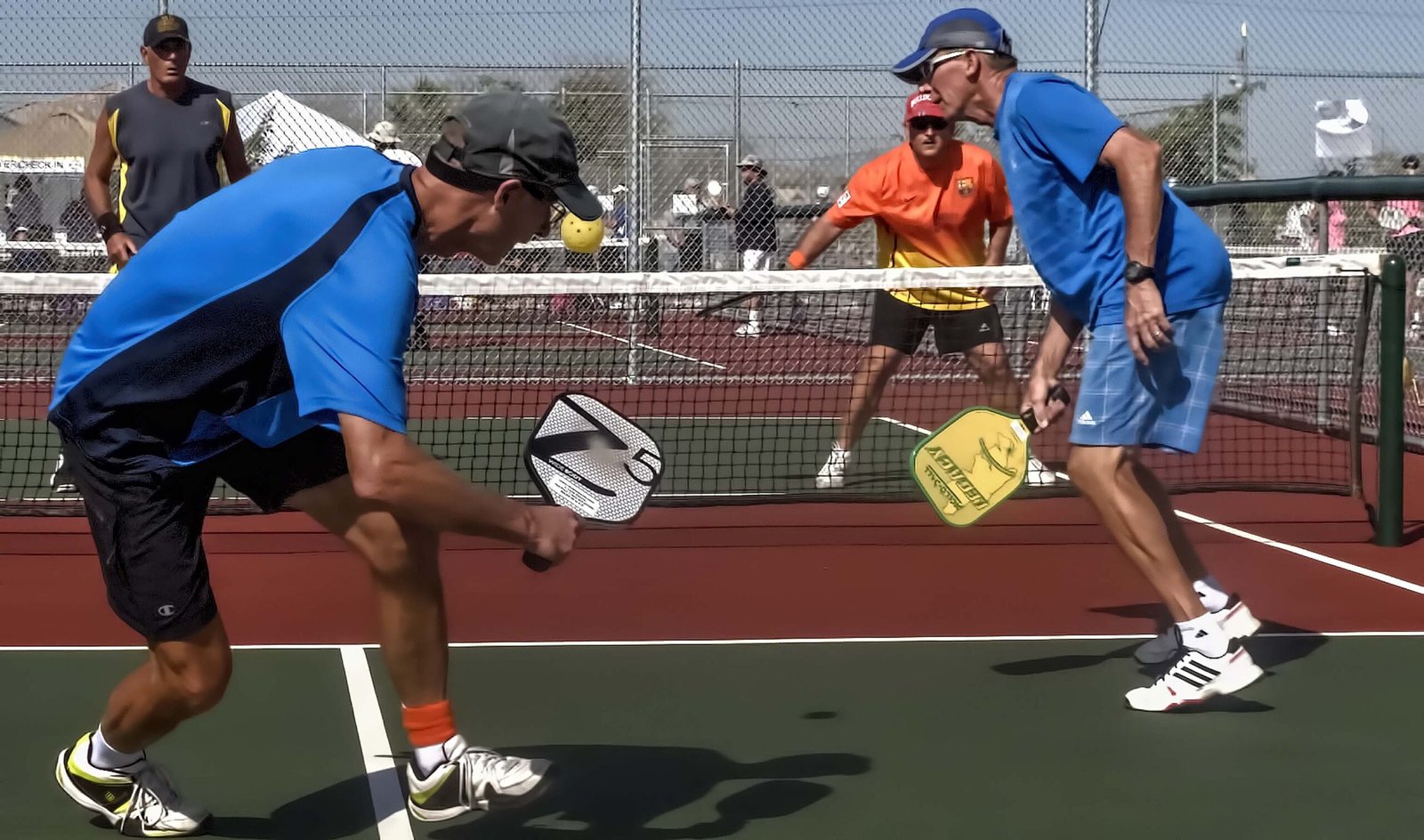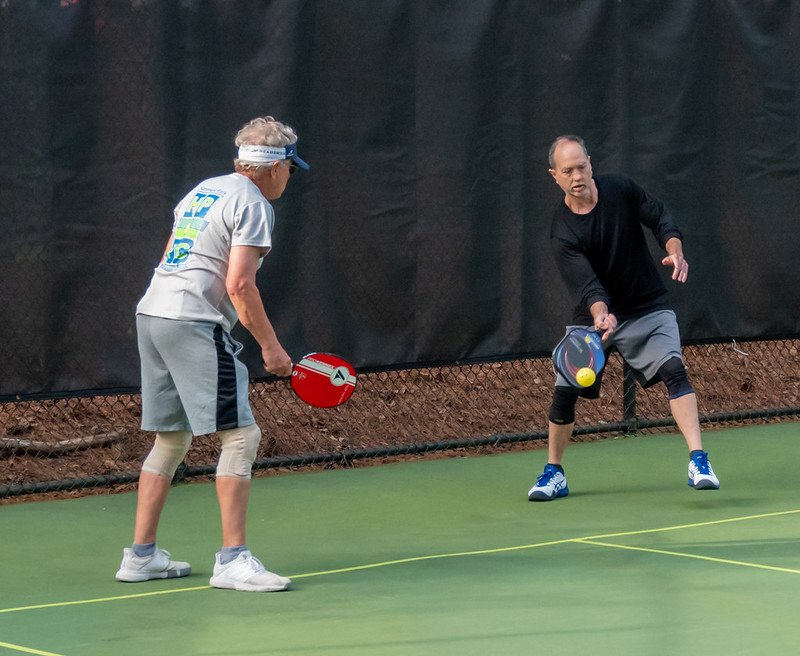Pickleball, often hailed as the fastest-growing sport in America, is a unique amalgamation of athleticism, strategy, and camaraderie. Originating in the mid-1960s, this captivating game was invented on Bainbridge Island, Washington, by Joel Pritchard, Bill Bell, and Barney McCallum. Initially conceived as a means to entertain their families, pickleball has since transcended its humble beginnings to become a global sensation.
At its core, pickleball blends elements from various racket sports, including tennis, badminton, and table tennis, resulting in a dynamic and accessible game suitable for players of all ages and skill levels. Its rapid rise in popularity can be attributed to several factors, including its simplicity, low barrier to entry, and adaptability to different environments.
One of the defining characteristics of pickleball is its emphasis on inclusivity and community engagement. Unlike some sports that may require specialized equipment or extensive training, pickleball welcomes newcomers with open arms, providing an environment where players can quickly learn the basics and enjoy competitive play. Whether played casually in a local park or at a national championship event, pickleball fosters a sense of camaraderie and sportsmanship that transcends competition.
In this comprehensive guide, we delve deep into the world of pickleball, exploring its rules, strategies, and the vibrant community that surrounds it. From the dimensions of the court to the nuances of scoring, serving, and gameplay tactics, we leave no stone unturned in our quest to unravel the intricacies of this exhilarating sport.
Whether you’re a seasoned pickleball veteran or a curious newcomer eager to pick up a paddle for the first time, join us on this journey as we uncover the secrets to success on the pickleball court and celebrate the joy of play that unites enthusiasts around the globe.
Table of Contents

Why do they call it pickleball?
The origin of the name “pickleball” is shrouded in a delightful tale that adds a whimsical touch to the sport’s history. The game’s vocabulary is often attributed to the Pritchard family, specifically to Joel Pritchard, one of the sport’s co-creators.
Legend has it that in the summer of 1965, on Bainbridge Island, Washington, Joel Pritchard and his friends Bill Bell and Barney McCallum returned home after a game of golf to find their families bored and in search of a new form of entertainment. The trio, spurred by a desire to create something engaging for their children, decided to fashion a makeshift game using elements from various sports.
They set up a badminton court but needed help locating the shuttlecock. Undeterred, they substituted a perforated plastic ball, which happened to belong to one of their dogs named Pickles. The dog, Pickles, was known for chasing stray balls during their initial experiments. Thus, the Pritchards aptly named their new creation “pickleball” as a nod to their four-legged companion, who inadvertently became a part of the game’s early history.
The name “pickleball” also carries a humorous anecdote beyond the canine connection. Joel Pritchard’s wife, Joan, recalls that the game was initially referred to as “Pritchard’s Pickle,” named after the family. However, over time, the colloquial name stuck, and “pickleball” became the universally accepted term for this burgeoning sport.
The charming story behind the name adds character to the sport, and pickleball enthusiasts fondly recount the tale as part of the game’s folklore. Regardless of its origin, the name has become synonymous with a sport that continues to grow in popularity, bringing joy and a sense of community to players around the world.
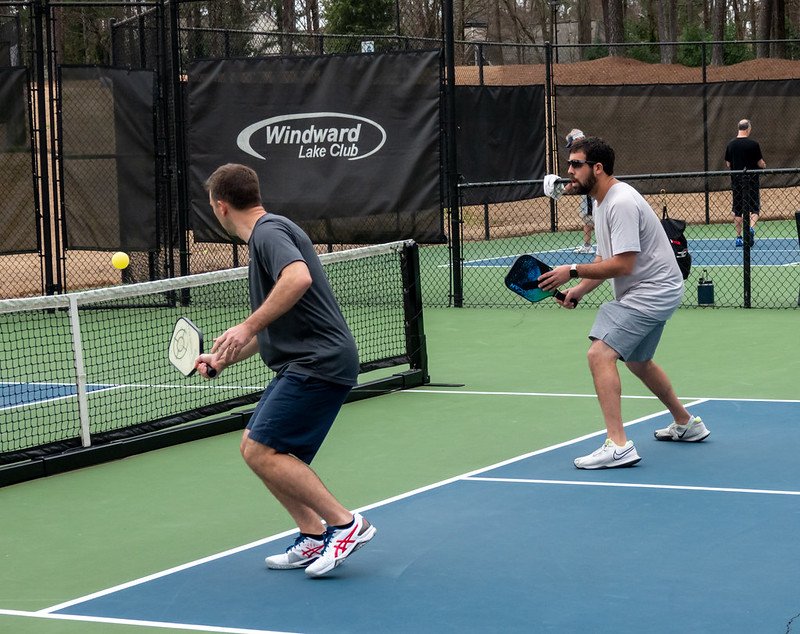
What is pickleball, and why is it so popular?
Pickleball, a relatively recent addition to the sports landscape, has surged in popularity owing to its unique blend of accessibility, fast-paced gameplay, and widespread appeal. Originating in the 1960s, the sport was conceived as a family-friendly activity, and its rise to prominence can be attributed to several key factors.
At its essence, pickleball is a paddle sport that draws inspiration from tennis, badminton, and table tennis. Played on a smaller court with a low net, participants wield solid paddles to hit a perforated plastic ball. The game incorporates elements of strategy, agility, and reflexes, making it engaging for players of diverse ages and skill levels.
One of the primary reasons for pickleball’s popularity is its ease of learning. The game’s rules are straightforward, and newcomers can quickly grasp the fundamentals, allowing for an immediate sense of participation and enjoyment. The simplicity of the sport, combined with its adaptability for players of varying physical abilities, has led to a surge in interest, particularly among older adults looking for a low-impact yet exhilarating activity.
Pickleball’s versatility contributes significantly to its widespread adoption. It can be played both indoors and outdoors, and adjustments can be made to court dimensions, making it feasible for diverse settings such as community centers, parks, and retirement communities. This adaptability has facilitated the creation of a broad community of players globally.
Furthermore, the friendly nature of pickleball has played a pivotal role in its rise to popularity. The sport encourages interaction and camaraderie among players, fostering a sense of community. Whether played casually in local parks or competitively at organized tournaments, pickleball provides a platform for social connection, enhancing its appeal and contributing to its rapid growth.
Pickleball’s popularity can be attributed to its simplicity, adaptability, and the sense of community it fosters, making it a sport that resonates with individuals seeking both physical activity and social engagement.
Pickleball: An Overview
- Introduction to Pickleball
Pickleball, a dynamic paddle sport, seamlessly blends tennis, badminton, and table tennis elements. Played on rectangular courts, whether indoors or outdoors, the game features a central net. Participants employ solid paddles to volley a perforated plastic ball, engaging in fast-paced rallies. This versatile sport caters to enthusiasts of various ages and skill levels, contributing to its widespread popularity. The combination of strategy, agility, and sociability on the court makes pickleball an accessible and engaging activity for players seeking a dynamic and inclusive sporting experience.
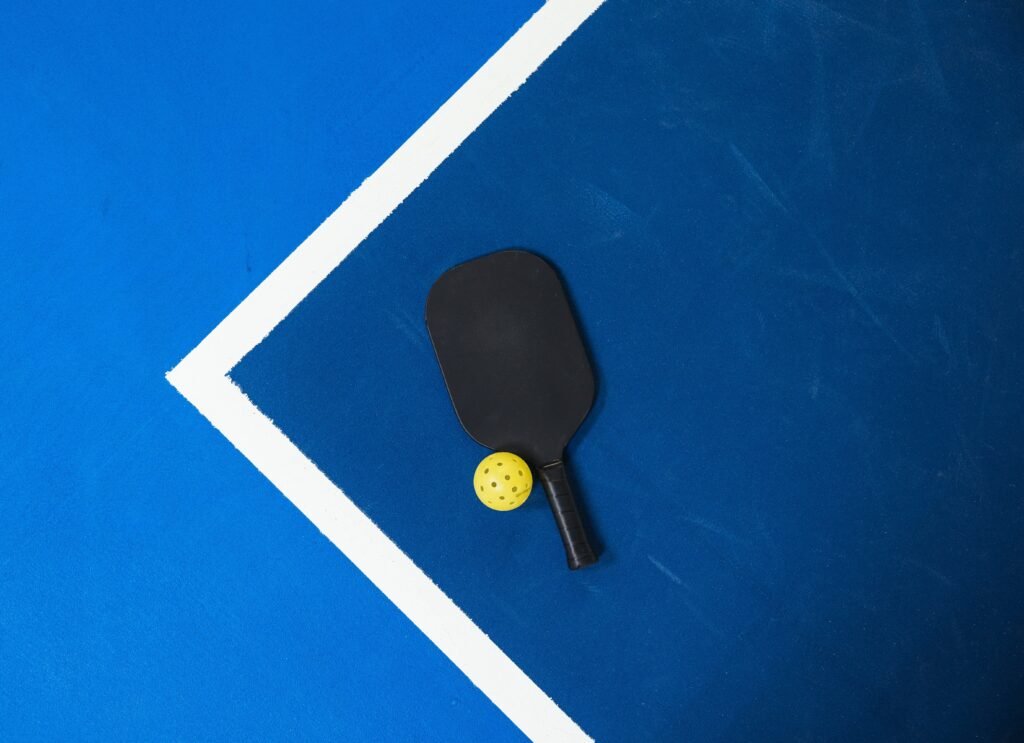
- Court and Equipment
Court Dimensions
The pickleball court is meticulously designed to accommodate both singles and doubles play, with distinct dimensions tailored to each format. For doubles matches, the court spans 20 feet in width and 44 feet in length. This expansive playing area ensures ample space for dynamic movement and strategic play, allowing pairs of players to engage in fast-paced rallies and intricate teamwork.
In contrast, the singles court is slightly more compact, measuring 20 feet in width and 22 feet in length. The reduction in size is a deliberate adjustment that caters to the one-on-one dynamics of singles play, offering a balance between challenge and maneuverability for individual competitors.
A pivotal element in the court’s configuration is the 34-inch net that bisects it into two halves. The net serves as both a physical and strategic barrier, compelling players to execute precise shots over its height and strategically positioning themselves to exploit their opponent’s weaknesses. This net height strikes a balance, requiring skillful shot placement while allowing for exciting volleys and net play.
The dimensions of the pickleball court, coupled with the strategic placement of the net, contribute to the nuanced gameplay and exciting dynamics that have propelled the sport to widespread acclaim among players of varying skill levels.
Paddle
In pickleball, players wield paddles that occupy a distinctive middle ground – larger than the compact paddles used in table tennis but more compact than the expansive racquets employed in tennis. These paddles, a pivotal element of the game, serve as the conduit through which players engage in strategic rallies and execute precision shots.
Crafted with careful consideration, pickleball paddles are predominantly fashioned from three primary materials: wood, composite materials, or a hybrid combination of both. Wooden paddles offer a classic feel and are often favored for their affordability and simplicity. On the other hand, composite paddles, constructed from materials such as graphite or fiberglass, bring a modern touch to the game. These materials provide enhanced durability, power, and control, catering to the preferences of more advanced players. Hybrid paddles, combining the best of both worlds, aim to strike a balance between tradition and innovation.
The choice of paddle material is a personal preference, with players selecting paddles that align with their playing style, skill level, and comfort. This diversity in paddle options adds an extra layer of customization to the sport, contributing to the rich tapestry that is pickleball equipment.
Ball
Pickleball employs a distinctive perforated plastic ball, reminiscent of a wiffle ball, to facilitate its dynamic gameplay. What sets this ball apart is the intentional inclusion of holes, a design element that significantly impacts its aerodynamic properties.
The perforations in the pickleball serve a dual purpose. Firstly, they reduce air resistance as the ball moves through the air. This feature enhances the ball’s speed, making rallies faster and gameplay more exciting. The reduced air resistance also contributes to the characteristic popping sound that resonates on the pickleball court, adding an auditory dimension to the overall experience.
Secondly, the holes in the ball affect its bounce and trajectory. The perforations alter the ball’s interaction with the paddle, court surface, and even wind conditions, introducing an element of unpredictability to each shot. This nuanced aerodynamics demands a level of skill and adaptability from players, as they must factor in these variables when strategizing and executing their moves on the court.
The design of the perforated plastic ball in pickleball is not merely a stylistic choice; it is a deliberate engineering feature that enhances the sport’s speed, excitement, and strategic depth, making each match a captivating interplay of skill and aerodynamics.
- Scoring and Serving

Scoring System
The scoring system adds an exciting dimension to the game, emphasizing both precision and endurance. Games are conventionally played to 11 points but with a unique twist – the winning team must secure victory by a margin of at least two points. This rule introduces an element of suspense and strategy as teams strive not only to reach the 11-point threshold but also to maintain a distinct lead over their opponents.
Crucially, only the serving team can accumulate points. This distinctive feature distinguishes pickleball from some other racket sports and adds a layer of strategic depth to the gameplay. The serving team aims not only to execute well-placed serves but also to capitalize on subsequent volleys and rallies to accrue points.
This scoring structure demands a delicate balance between offensive prowess and defensive resilience. Teams must not only showcase skill in serving but also demonstrate consistency and adaptability throughout the match. The requirement to win by a two-point margin intensifies the competition, creating exhilarating moments as teams vie for a decisive advantage in their pursuit of victory. Ultimately, the scoring system in pickleball contributes to the sport’s dynamic nature and ensures that every point is earned through strategic prowess and skillful play.
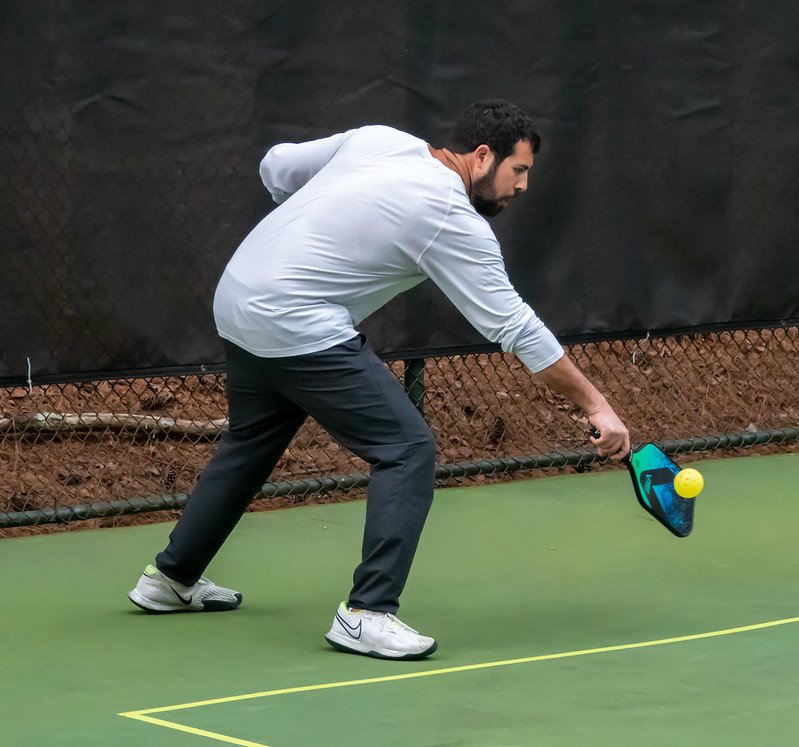
Serving
Serving is a critical aspect of gameplay, governed by specific rules to ensure fairness and strategic engagement. The serving team positions themselves behind the baseline, a boundary at the rear of the court. With precision, they execute an underhand serve, a distinctive feature of pickleball, differentiating it from overhand serves common in sports like tennis.
The serve is directed diagonally, traversing the net to reach the opponent’s service court. This diagonal trajectory introduces an element of strategy, requiring the serving team to consider placement and angle. Notably, the serve must clear the net at a height, allowing opponents the opportunity to return the ball adding a layer of sportsmanship and fairness to the game.
The underhand serve, a foundational pickleball technique, demands control and finesse. Players strive for accuracy, aiming to land the serve within the opponent’s service court. A well-executed serve sets the tone for the rally that ensues, influencing the dynamics of the game and positioning the serving team strategically.
This underhand serving process not only contributes to the unique character of pickleball but also underscores the sport’s commitment to inclusivity and approachability, allowing players of varying skill levels to participate and enjoy the game.
- Gameplay Rules
Double Bounce Rule
The double bounce rule stands as a foundational element, shaping the pace and dynamics of the game. This rule dictates that following the serve, both teams must allow the ball to bounce on their respective sides before engaging in volleys, which involve hitting the ball without letting it bounce. This unique regulation injects a strategic dimension into the sport, as players strategically position themselves to capitalize on the bounce and gain a favorable position on the court.
By mandating this initial double bounce, pickleball fosters a balance between offense and defense. Players must tactically position themselves, anticipating the ball’s trajectory after the serve and subsequent bounces. This rule not only emphasizes quick reflexes but also rewards astute court awareness and positioning.
The double bounce rule is instrumental in ensuring fair play and an engaging experience for participants, particularly in doubles play. It offers players an opportunity to organize their strategy, retrieve the ball strategically, and initiate volleys in a controlled manner. As a result, this rule contributes to the unique and dynamic nature of pickleball, where precision, timing, and strategic prowess play pivotal roles in achieving success on the court.
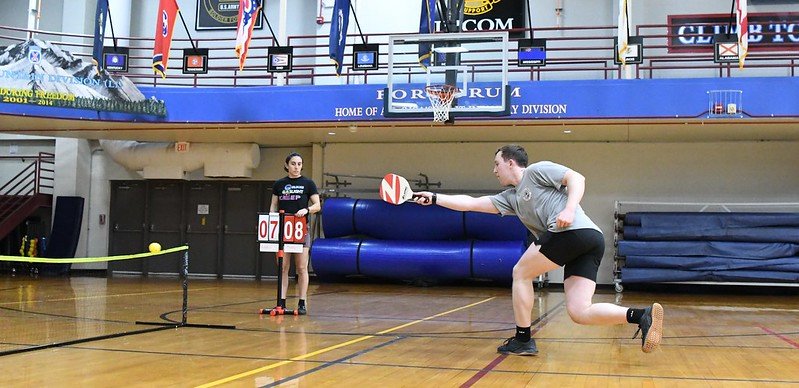
Non-Volley Zone
In pickleball, a distinctive feature is the presence of a seven-foot non-volley zone, affectionately known as “the kitchen,” situated on both sides of the net. This designated area adds an intriguing layer to the gameplay, shaping the strategy and tactics employed by players. The kitchen spans seven feet from the net, creating a unique dynamic near the center of the court.
A crucial rule dictates that players are generally prohibited from volleying the ball while standing within this non-volley zone. Volleying, or hitting the ball in the air without allowing it to bounce, is a common technique in pickleball. However, the introduction of the kitchen rule adds an element of finesse to the game.
While players are generally restricted from volleying within the non-volley zone, there are exceptions to this rule. For instance, if the ball bounces within the kitchen, players can enter this area to make their shots. This nuanced regulation adds strategic depth, compelling players to carefully time their movements in and out of the kitchen, enhancing the overall tactical nature of pickleball. The kitchen rule not only governs player behavior but also contributes to the game’s balance, requiring participants to master the art of precision and positioning near the net.
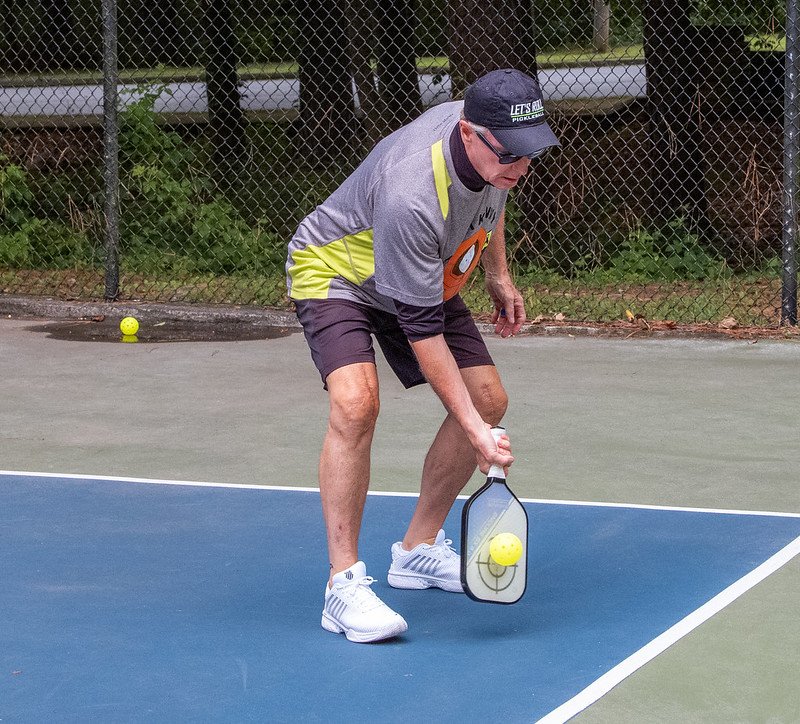
Faults
Players must adhere to specific rules to maintain fair play and uphold the integrity of the sport. Common faults, or rule violations, can occur during various phases of the game, impacting the flow and outcome of a match.
Stepping into the non-volley zone to volley is a prevalent fault. The non-volley zone, often referred to as “the kitchen,” is a seven-foot area adjacent to the net on both sides of the court. Players are prohibited from executing volleys (hitting the ball before it bounces) while standing inside this zone, preventing them from gaining an unfair advantage by being too close to the net.
Hitting the ball out of bounds is another frequently observed fault. Players must maneuver the ball within the designated court boundaries, and any deviation beyond the lines results in a fault. Precision and control become paramount to avoid losing points due to inaccuracies in ball placement.
Failure to clear the net during the serve is a crucial fault during the initial stages of a point. The serve must be executed with an underhand motion, clearing the net and landing within the opponent’s service court. This rule leads to a fault and also denies the serving team the opportunity to initiate the point successfully.
These common faults underscore the importance of players’ adherence to the rules, ensuring a fair and competitive environment in the spirited game of pickleball.
- Strategy and Tactics
Strategic finesse takes center stage as players engage in a tactical dance on the court in Pickleball. A key aspect of the gameplay involves astute maneuvers to dominate the kitchen, a seven-foot non-volley zone situated near the net. Players strategically position themselves to control this crucial area, aiming to limit their opponents’ options and force them into challenging positions.
The kitchen strategy revolves around restricting opponents from volleying near the net, compelling them to hit shots from a less advantageous distance. By executing precise shots and well-timed volleys, players can exploit their adversaries’ vulnerabilities and create opportunities for winning points.
Success in pickleball hinges on a trifecta of skills: quick reflexes, unwavering agility, and strategic positioning. The fast-paced nature of the game demands split-second decisions, requiring players to react swiftly to incoming shots. Agility is paramount, enabling players to cover the court efficiently and respond to the unpredictable trajectories of the ball. Strategic positioning complements these skills, as players aim to be in optimal locations to anticipate and counter their opponent’s moves.
Ultimately, the interplay of strategic understanding, physical agility, and precise positioning forms the backbone of success in pickleball, transforming each match into a thrilling display of skillful finesse and strategic prowess.
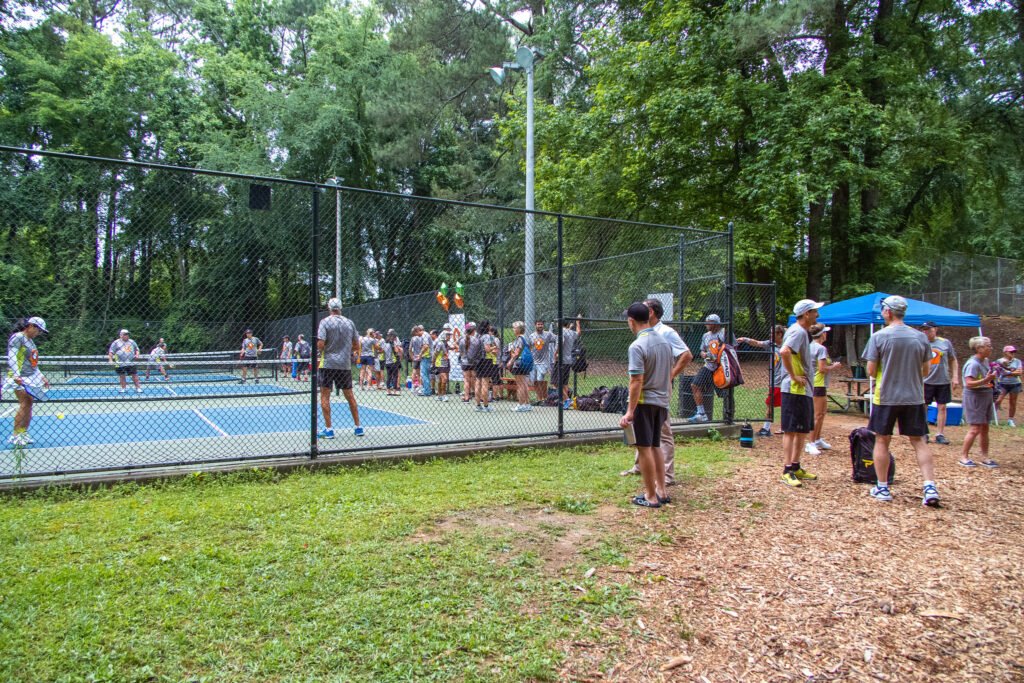
- Popularity and Community
Pickleball has experienced a remarkable surge in popularity, with a notable trend of widespread adoption, particularly among older adults. This growing demographic is increasingly drawn to pickleball due to its inherent benefits for joint health. The sport’s lower impact on joints, compared to more strenuous activities, makes it an attractive option for individuals seeking a physically engaging yet gentle form of exercise. This appeal has turned pickleball into a preferred choice for seniors, contributing significantly to its burgeoning popularity within this age group.
The rise of pickleball has also led to the establishment of vibrant communities, clubs, and tournaments on a global scale. Enthusiasts and players from various backgrounds have come together to form dedicated communities centered around their shared love for the sport. Local clubs provide spaces for players to gather, socialize, and enjoy friendly matches. Moreover, the proliferation of pickleball tournaments, ranging from local competitions to international events, showcases the sport’s increasing influence on the global stage. These organized gatherings not only fuel the competitive spirit but also foster a sense of camaraderie among players, contributing to the enduring and expanding popularity of pickleball worldwide.
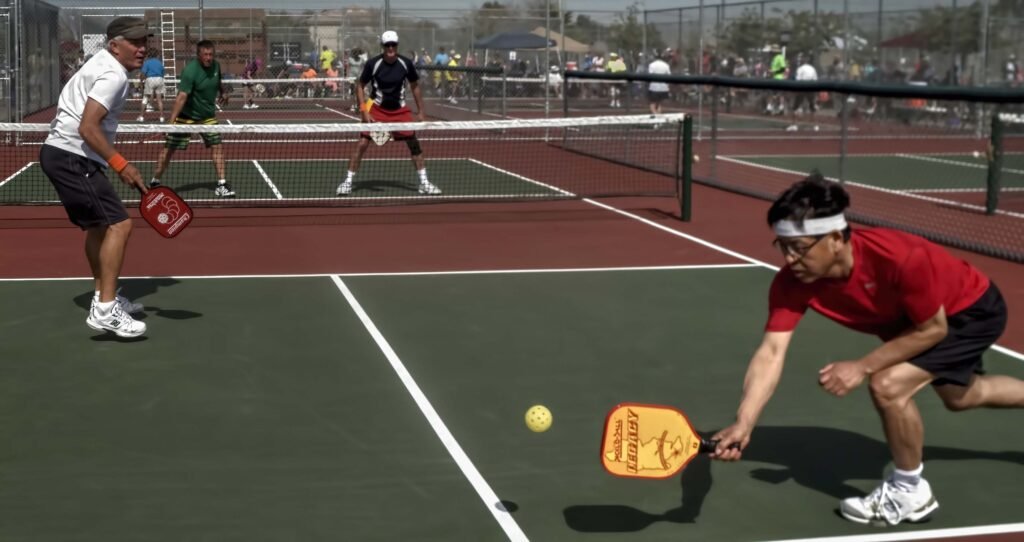
- Adaptive Nature
Pickleball’s adaptability lies at the heart of its widespread appeal, allowing individuals of all skill levels and physical abilities to participate and enjoy the game. Unlike some sports that may require extensive training or specialized equipment, pickleball welcomes players with diverse backgrounds, making it accessible to a wide range of enthusiasts.
One of the key aspects of pickleball’s adaptability is its flexibility in accommodating modifications. Court dimensions can be adjusted to fit different spaces, whether it’s a traditional indoor court or a makeshift outdoor setup in a community park. Similarly, variations in equipment, such as paddle size and ball type, can be tailored to suit the needs and preferences of players, further enhancing the inclusivity of the sport.
Moreover, pickleball’s rules are designed to be adaptable, allowing for modifications that accommodate players with varying skill levels. This flexibility ensures that individuals can enjoy the game at their own pace and comfort level, whether they’re casual players looking for recreation or competitive athletes seeking a challenge.
Overall, pickleball’s adaptability makes it a versatile and inclusive sport that caters to the diverse needs and abilities of its participants, reinforcing its status as a beloved pastime enjoyed by millions around the world.
- Continuous Evolution
Pickleball, while rooted in tradition, stands as a dynamic sport in constant evolution. The community surrounding pickleball engages in continuous dialogue, fostering a culture of adaptability and improvement. This evolution is prominently reflected in ongoing discussions about various facets of the game.
Rule adjustments form a significant part of the sport’s evolution. The pickleball community regularly assesses and refines the rules to enhance fairness, competitiveness, and overall player experience. These discussions often address nuanced aspects of the game, ensuring that the sport remains both accessible for beginners and challenging for seasoned players.
Equipment innovations also contribute to the sport’s evolution. Paddle technology, ball design, and court materials are areas that see continuous exploration and improvement. As technology advances, players benefit from equipment that enhances performance and durability, further elevating the overall pickleball experience.
The development of competitive standards is another crucial aspect of pickleball’s evolution. As the sport gains recognition on a global scale, establishing consistent standards for tournaments and competitions becomes imperative. This process involves refining scoring systems, tournament formats, and player rankings, ensuring a standardized and equitable competitive landscape.
Pickleball’s evolution is a collaborative effort involving players, officials, and enthusiasts alike. The ongoing discussions about rule adjustments, equipment innovations, and competitive standards underscore the sport’s commitment to growth, ensuring that pickleball remains a vibrant and progressive activity for current and future generations of players.
Pickleball, a dynamic and engaging sport, has garnered widespread popularity across diverse demographics. Beyond the exhilarating gameplay, pickleball has become a catalyst for community building. The sport provides a welcoming environment, fostering social connections and a sense of camaraderie among players. Whether played casually in local parks or competitive tournaments, pickleball’s versatility contributes to its universal appeal. Its adaptability for various settings, combined with the ease with which beginners can grasp its fundamentals, makes pickleball a versatile recreational option. Embraced by both seasoned athletes and those new to racket sports, pickleball stands out as a vibrant and inclusive activity that continues to enrich the lives of its enthusiasts.


